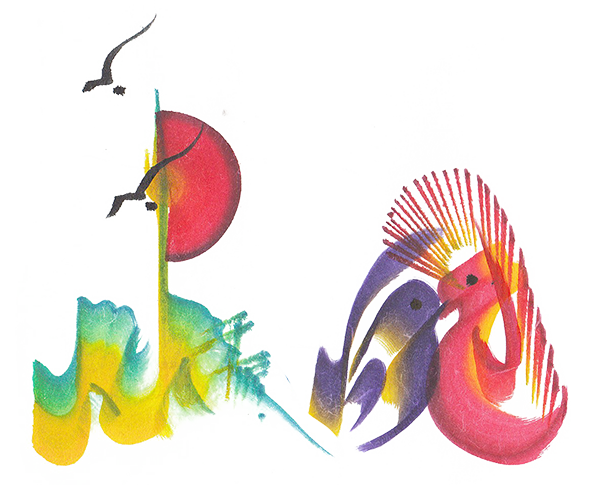SEE HERE : BARELY CONTAINED
If you’ve ever travelled on a plane and sat next to a window during take off, you may have registered a moment when you get just far enough away from the ground so that the scene you’ve left behind looks fake. Individual people disappear and the pools of light from car headlights and streetlights becomes like lasers and spilled paint. From this height, you lose your physical connection with what’s happening on the ground, and that miniature world doesn’t feel like it’s yours. Sometimes that’s a nice feeling. Politically, though, it’s dangerous.
Brooklyn-based, Kenyan-born artist Wangechu Mutu remarked in Sarah Thornton’s 33 Artists in 3 Acts that ‘Successful art can be made by people who don’t worry about their responsibility to humanity, but that isn’t an option for me.’ Making art is like looking at art in this way - you can address and engage with the reality of the worst of what you know to be happening around you, or you can choose not to, pretending instead that if you are far away, physically and ideologically, then it simply doesn’t matter. Put it all in a box labelled “Does Not Affect Me” and put it away.
In October last year I stumbled on a shipping container in Edinburgh’s Grassmarket. It was heavily graffitied on the outside, and as I got nearer I noted big steel grommets puncturing the surface at random points like bullet holes. A container in a public place is not ominous: it’s just as likely to be an edgy pop-up cafe as it is a confrontational public art piece. This turned out to be the latter, James Cauty’s The Aftermath Dislocation Principle (ADP). Other passers-by were pressing their eyes to the grommets, so I found some that I could reach and stopped and did the same. I stepped back, and then looked again. Inside was a hyper-realistic city in miniature in the throes of what looked like some kind of apocalypse.
You may remember Cauty from the KLF, and if you don’t remember the chart-toppers you’ll remember the antics: machine-gunning blanks into the audience at the Brit Awards before announcing their retirement (and then deleting their whole back catalogue months later), or, most famously, ceremonially setting fire to £1 million in cash of their own money on the Isle of Jura. Cauty’s current work is a bit more, if you will, contained.
And no less effective for being so, either. In fact, it’s the very containedness of the work that makes it so threatening. This container was part of the ADP, a trilogy of 1:87 scale models of post-riot landscapes travelling the country after being unveiled in Banksy’s Dismaland project in 2015. It stopped to set up shop at sites of famous riots (the Grassmarket was the site of the 1736 Porteous Riots, where police fired into a crowd of civilians gathered for a public hanging, killing six). Eerily and crucially, each landscape contains only the media and emergency services - no civilians. The diorama is vast and meticulous - we scanned the surface impatiently for more grommets through which to peer, our eyes confused by the thick graffiti on the surface that acted like a Magic Eye illustration.
In his exhaustive article ‘Container Aesthetics: The Infrastructural Politics of Shunt’s The Boy Who Climbed Out of His Face,’ Michael Shane Boyle outlines a history of the container, the bedding-in of this steely symbol of commerce and capitalism in many iterations of the every-day, whence it makes its way to the theatre, and then the art world:
With migrant-detention centers, military barracks, and jails now being built out of the stuff, shipping containers are proving their profoundly democratic potential: they are as fit to be playgrounds for the rich as they are prisons for the poor.
Through the graffiti on its surface, flyers being handed out, and the muralist Chris Rutterford and graffiti artist Elph magicking up their own riot scenes nearby, it was clear from fifty paces that this was an art event. That moment of realisation, though, is one that artists and theatre companies prey on when they involve containers in their work: when we see a container, we have no idea what’s inside.
This container does not contain a migrant’s worldly goods, milk powder, deer pelts, or a cafe - it contains chaos. It’s a Pandora’s box. Worse still, it’s a recognisable sort of chaos, one that’s been artfully draped over familiar markers of our quotidian innocence (and ignorance) - petrol stations, hospitals and McDonald's drive-thrus. The container heightens the deliberateness of the work and baits viewers - this carrot-and-stick approach is what made the scene I discovered inside more of an explicit threat. If you do not pay attention, you will unleash this. We are on the edge.
I wasn’t forced to enter that world, could not, in fact, not even mentally. Just weeks later I remembered it, though, as the POTUS who I will not name rose to power. Recent international events have proven we have not learnt not to open Pandora’s little box. Maybe a few years ago, in my ignorance, the ADP’s contents would not have frightened me, having been beyond what I believed I would ever personally experience. Now, it seems, the door has been opened a crack, and it will take many more of us many years to slam it shut again.
NB: Incidentally, the KLF appear to be reforming this year. Look out.







MARCH 2017
SEE HERE is a monthly musing on a single artwork from anywhere, written by Amy Stewart: @A_L_STEWED // ASTEWARTWRITING.COM.

